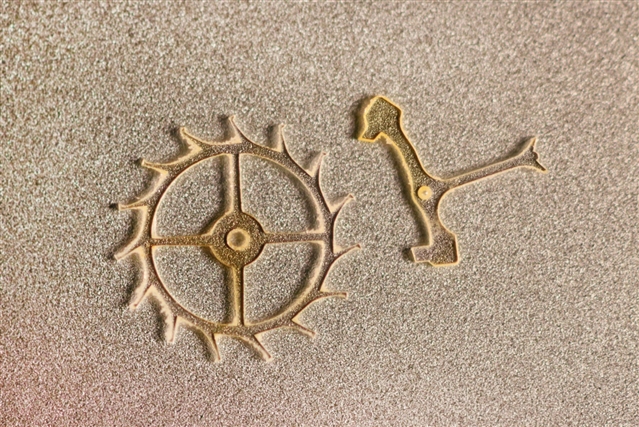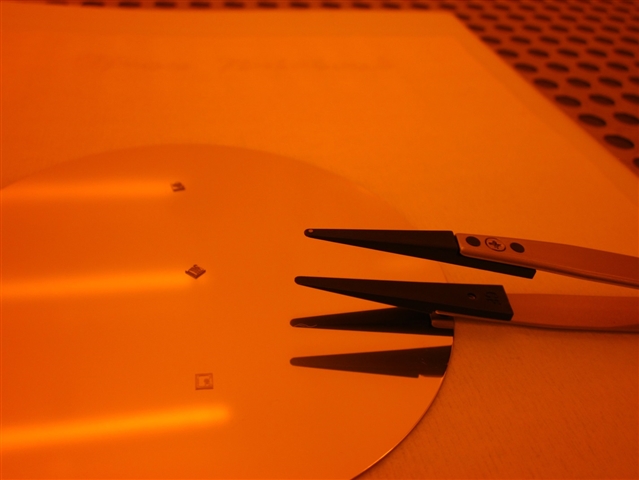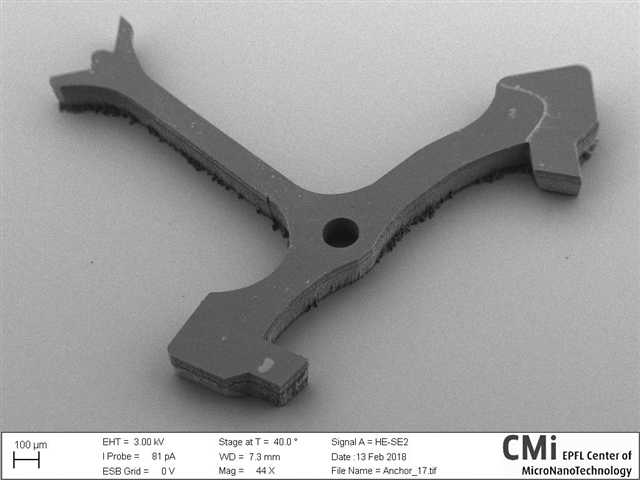论文标题:Precision micro-mechanical components in single crystal diamond by deep reactive ion etching
期刊:Microsystems & Nanoengineering
作者:Adrien Toros, Marcell Kiss, Teodoro Graziosi, Hamed Sattari, Pascal Gallo & Niels Quack
发表时间:2018/6/18
数字识别码: 10.1038/s41378-018-0014-5
原文链接:https://www.nature.com/articles/s41378-018-0014-5?utm_source=Other_website&utm_medium=Website_links&utm_content=JesGuo-Nature-Microsystems_and_Nanoengineering-Engineering-China&utm_campaign=NROAAJ_USG_JRCN_JG_Contenthighlight

在瑞士国家科学基金会的支持下,研究人员发明了一项雕刻材料的新技术,用来构建微机械系统。其中最特别的部分,就是他们利用人造单晶金刚石生产出了一种极其微小的手表部件。
金刚石质地坚硬,韧度十足,有很好的导热性,并且高度透明,因此是很多机械设备和光学装置的理想材料。但同时,要将金刚石进行微米级(千分之一毫米)的精确切割又十分具有挑战性。在瑞士国家科学基金会的资助下,来自瑞士洛桑联邦理工学院的Neils Quack教授和他的团队发明了一种新的方法,可以从人造单晶金刚石上雕刻出一个微机械手表系统,即一只直径三毫米的擒纵轮和擒纵叉。

图一:擒纵轮,人造金刚石制,宽3mm
“反应离子刻蚀”技术广泛应用于计算机芯片领域,该团队对这一技术作了改善,成功地将人造金刚石刻蚀成0.15毫米厚的三维形状,比现存最厚的结构厚三倍。“我们正在逐渐靠近手表行业的标准厚度,也就是0.2毫米。”Quack说道,“这项技术引起了行业内关注,目前我们正在和一个瑞士手表公司洽谈。我们认为金刚石可以减少摩擦,增加动力储存,即延长手表需要再次上发条的时间。不过这还只是个有待证实的假设。”在制表业,金刚石还有其他的优点:它具有透明度,可以进行上色,此外,金刚石的无磁性也正是当前市场高度追捧的属性。

图二:镊子尖端一个直径0.75mm的金刚石擒纵轮,下为一硅晶片,装配过程中作为支架

图三:一只单晶人造金刚石制的手表部件擒纵叉
工业专利
之前,由于离子(带电原子)在电场加速时,不仅移动了选定位置的金刚石焊层,还侵蚀了规定目标形状的膜层,“反应离子刻蚀”技术只能产生厚度为0.05毫米的结构。因此,所得结构的厚度受到膜层抗力和厚度的限制。瑞士洛桑联邦理工学院微电子学研究所一位名叫Adrien Toros的科研助手在不到半年时间内,发明了一种双层膜,这种膜由一层铝和一层二氧化硅构成,铝层能很好地吸附金刚石,其外的二氧化硅层较厚,更能抵抗离子反应的影响。该项技术能加快刻蚀过程,实现几近垂直的深入切割。
在Innosuisse(此前为CTI)的支持下,该团队计划同瑞士的人造金刚石生产商Lake Diamond合作,此前他们已经共同申请了一项专利。该公司的首席执行官Pascal Gallo透露:“在中期我们将利用这项技术进行微米级部件的精准生产和商业化,从而扩大我们的制造领域。”
此外还有另一个项目也在实施中,研究人员正在努力从超纯金刚石中制作光学元件,例如,热成像过程中能在红外光谱中进行操作的透镜,以及工业切割所使用的激光器件等。
Niels Quack说:“2015年我开始这项研究时,从未设想过这些工业应用。但是多亏了Gebert Rüf Stiftung基金会的支持,让我们很快看到了项目的大好前景,然后成功地将其发展成实用的工业应用。于我而言,这完美地证明了基础研究经常会带来一些意想不到的应用,这对于工业领域来说十分具有吸引力。保持思维开放太重要了!”
这项研究在瑞士洛桑联邦理工学院进行,受瑞士国家科学基金会的SNSF Professorship支持(这项基金计划现已改为SNSF Eccellenza Professorial Fellowhips)。同时该项目也受到Gebert Rüf Stiftung基金会和位于伊韦尔东的Lake Diamond公司的支持,后者提供了人造单晶金刚石。该公司的首席执行官Pascal Gallo是论文的合著者。这些部件在瑞士洛桑联邦理工学院的微纳米技术中心进行了装配。
联系本文作者:
Prof. Niels Quack
Institut de microtechnique
EPFL
CH-1015 Lausanne
Tel.: +41 21 693 73 83, +41 78 604 76 54
E-mailniels.quack@epfl.ch
Web:http://q-lab.epfl.ch
相关链接:
•图一:擒纵轮,人造金刚石制,宽3mm
•图二:镊子尖端一个直径0.75mm的金刚石擒纵轮,下为一硅晶片,装配过程中作为支架
•图三: 一只单晶人造金刚石制的手表部件擒纵叉
• 原博文链接:http://www.snf.ch/en/researchinFocus/newsroom/Pages/news-180618-press-release-diamond-watch-components.aspx
摘要:The outstanding material properties of single crystal diamond have been at the origin of the long-standing interest in its exploitation for engineering of high-performance micro- and nanosystems. In particular, the extreme mechanical hardness, the highest elastic modulus of any bulk material, low density, and the promise for low friction have spurred interest most notably for micro-mechanical and MEMS applications. While reactive ion etching of diamond has been reported previously, precision structuring of freestanding micro-mechanical components in single crystal diamond by deep reactive ion etching has hitherto remained elusive, related to limitations in the etch processes, such as the need of thick hard masks, micromasking effects, and limited etch rates. In this work, we report on an optimized reactive ion etching process of single crystal diamond overcoming several of these shortcomings at the same time, and present a robust and reliable method to produce fully released micro-mechanical components in single crystal diamond. Using an optimized Al/SiO2 hard mask and a high-intensity oxygen plasma etch process, we obtain etch rates exceeding 30 µm/h and hard mask selectivity better than 1:50. We demonstrate fully freestanding micro-mechanical components for mechanical watches made of pure single crystal diamond. The components with a thickness of 150 µm are defined by lithography and deep reactive ion etching, and exhibit sidewall angles of 82°–93° with surface roughness better than 200 nm rms, demonstrating the potential of this powerful technique for precision microstructuring of single crystal diamond.
阅读论文全文,请访问https://www.nature.com/articles/s41378-018-0014-5?utm_source=Other_website&utm_medium=Website_links&utm_content=JesGuo-Nature-Microsystems_and_Nanoengineering-Engineering-China&utm_campaign=NROAAJ_USG_JRCN_JG_Contenthighlight
期刊介绍:Microsystems & Nanoengineeringis an online-only, open access international journal devoted to publishing original research results and reviews on all aspects of Micro and Nano Electro Mechanical Systems from fundamental to applied research. The journal is published by Springer Nature in partnership with the Institute of Electronics, Chinese Academy of Sciences, supported by the State Key Laboratory of Transducer Technology.
2017 Journal Metrics:
Journal Impact Factor 5.071
Immediacy Index 0.92
Eigenfactor Score 0.001100
Article Influence Score 1.435
Rank 30/92 Nanoscience&Nanotechnology 3/61 Instrument & Instrumentation
(来源:科学网)
特别声明:本文转载仅仅是出于传播信息的需要,并不意味着代表本网站观点或证实其内容的真实性;如其他媒体、网站或个人从本网站转载使用,须保留本网站注明的“来源”,并自负版权等法律责任;作者如果不希望被转载或者联系转载稿费等事宜,请与我们接洽。